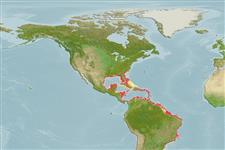>
Eupercaria/misc (Various families in series Eupercaria) >
Gerreidae (Mojarras)
Etymology: Eugerres: Greek, eu = good, well + Latin, gerres = a kind of anchovies; cited by Plinius.
More on author: Cuvier.
Environment: milieu / climate zone / depth range / distribution range
Ökologie
seewasser demersal; tiefenbereich ? - 30 m (Ref. 104866). Tropical; 34°N - 30°S, 98°W - 34°W
Western Central Atlantic: South Carolina, USA to Santa Catarina, Brazil (Ref. 57756). Probably occurs in Trinidad and Tobago and other islands of the Antilles (Ref. 5217).
Length at first maturity / Size / Gewicht / Alter
Maturity: Lm 15.0, range 14 - ? cm
Max length : 50.0 cm FL Männchen/unbestimmt; (Ref. 8571); common length : 20.0 cm TL Männchen/unbestimmt; (Ref. 5217)
Occurs in shallow water, over soft bottoms.
Life cycle and mating behavior
Geschlechtsreife | Fortpflanzung | Ablaichen | Eier | Fecundity | Larven
Cervigón, F., R. Cipriani, W. Fischer, L. Garibaldi, M. Hendrickx, A.J. Lemus, R. Márquez, J.M. Poutiers, G. Robaina and B. Rodriguez, 1992. Fichas FAO de identificación de especies para los fines de la pesca. Guía de campo de las especies comerciales marinas y de aquas salobres de la costa septentrional de Sur América. FAO, Rome. 513 p. Preparado con el financiamento de la Comisión de Comunidades Europeas y de NORAD. (Ref. 5217)
IUCN Rote Liste Status (Ref. 130435: Version 2024-2)
Bedrohung für Menschen
Harmless
Nutzung durch Menschen
Fischereien: kommerziell
Tools
Zusatzinformationen
Download XML
Internet Quellen
Estimates based on models
Preferred temperature (Ref.
123201): 23.9 - 28.1, mean 27.3 °C (based on 768 cells).
Phylogenetic diversity index (Ref.
82804): PD
50 = 0.5156 [Uniqueness, from 0.5 = low to 2.0 = high].
Bayesian length-weight: a=0.01660 (0.01195 - 0.02304), b=3.02 (2.97 - 3.07), in cm total length, based on LWR estimates for this species (Ref.
93245).
Trophic level (Ref.
69278): 3.4 ±0.43 se; based on food items.
Widerstandsfähigkeit (Ref.
120179): mittel, Verdopplung der Population dauert 1,4 - 4,4 Jahre. (tm=1; K=0.28-0.53(?)).
Fishing Vulnerability (Ref.
59153): Moderate vulnerability (37 of 100).
Nutrients (Ref.
124155): Calcium = 122 [60, 228] mg/100g; Iron = 0.936 [0.475, 1.789] mg/100g; Protein = 18.2 [16.3, 20.1] %; Omega3 = 0.157 [0.080, 0.299] g/100g; Selenium = 51.9 [25.3, 110.3] μg/100g; VitaminA = 11.2 [2.8, 37.0] μg/100g; Zinc = 0.964 [0.622, 1.478] mg/100g (wet weight);
